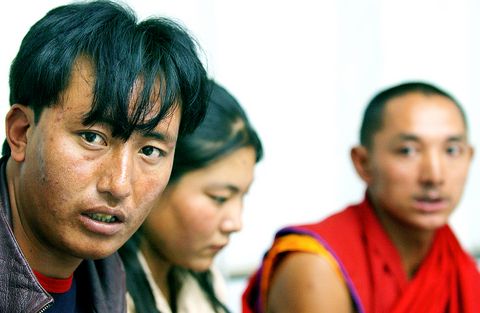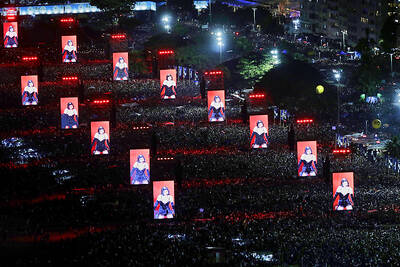For 17 days they waded through Himalayan snowdrifts and climbed ice-covered rocky terrain, cold, hungry and exhausted. Then came the shooting.
Early on Sept. 30, as 75 Tibetan refugees were making a secret trek across the border into Nepal, moving in single file across a mountain slope near the 5,800m high Nanpa La Pass, Chinese border guards opened fire.
One woman -- a 25-year-old Buddhist nun -- was killed immediately, group members said. Chinese officials, in a statement apparently about the shooting, have said a second person also died.

PHOTO: AFP
"There was no warning of any kind. The bullets were so close I could hear them whizzing past," Thubten Tsering, a Tibetan monk, told journalists in New Delhi on Monday. "We scattered and ran."
Thubten is among 41 of the refugees who survived the shooting and reached India. The survivors said they do not know the fate of 32 others, including nine children, who were taken into custody by the guards.
"We don't know where they are or what happened to them," said Thubten, his chapped cheeks and exhausted face still bearing the scars of the ordeal.
Footage of the incident, shot by a Romanian cameraman on a mountaineering expedition, sparked an international outcry.
The footage, which was released by Romania's Pro TV, shows a distant figure that its narrator says is a Chinese border guard firing a rifle and a separate scene of a person in a line of figures walking through the snow then falling to the ground. An unidentified man near the camera can be heard saying in English, "They are shooting them like, like dogs."
The activist group International Campaign for Tibet, in a written statement, said the video proves Chinese troops fired at unarmed Tibetans and counters a statement from Beijing that its forces were attacked and fired in self-defense.
The pass is a common escape route for fleeing Tibetans.
Thousands have left for Nepal since Chinese forces occupied their Himalayan homeland in 1951. Many make their way to the north Indian town of Dharmsala, the home of the Dalai Lama, the exiled Tibetan Buddhist spiritual leader and a Nobel Peace Prize laureate.
Every year more than 2,500 Tibetan refugees attempt the arduous trek, said Tenzing Norgay of the Tibetan Center for Human Rights and Democracy, which arranged the Monday news conference for the survivors.
When asked about his life in a monastery in Tibet where the monks are under the constant watch of Chinese security forces and under pressure to denounce the Dalai Lama, Thubten said simply: "It was stifling."
"Being a monk who has taken a vow to live by the faith, we were always under threat from the Chinese political authorities," he said.
Dolma Palkyid, a 15-year-old novice nun, was a close friend of Kelsang Nortso, the nun who was killed.
"I had walked ahead and we got separated. Then the shooting took place and we fled. It was four days later that I heard Kelsang was the one who was shot," she said, speaking haltingly and tearfully, through an interpreter.
Once in India, the friends were hoping to join another Buddhist nunnery together, said the red-cheeked teenager dressed in a traditional ankle-length gown.
The group of Tibetan refugees had each paid 5,000 yuan (US$625) to a guide to arrange the trip. They set off around the middle of last month, assured that the 10-day trek would deliver them to Nepal.
There have been instances of refugees being shot at by border guards in the past, but this was the first time in recent years that troops killed any, Tenzing said of the human rights group.
"This is the first time that the world has seen evidence of what Tibetans are subjected to by the Chinese," Tenzing said.
"Kelsang's death cannot go in vain. We will use this incident and the video footage to bring international pressure on China and press for Tibetan freedom," he said.

Kehinde Sanni spends his days smoothing out dents and repainting scratched bumpers in a modest autobody shop in Lagos. He has never left Nigeria, yet he speaks glowingly of Burkina Faso military leader Ibrahim Traore. “Nigeria needs someone like Ibrahim Traore of Burkina Faso. He is doing well for his country,” Sanni said. His admiration is shaped by a steady stream of viral videos, memes and social media posts — many misleading or outright false — portraying Traore as a fearless reformer who defied Western powers and reclaimed his country’s dignity. The Burkinabe strongman swept into power following a coup in September 2022

‘FRAGMENTING’: British politics have for a long time been dominated by the Labor Party and the Tories, but polls suggest that Reform now poses a significant challenge Hard-right upstarts Reform UK snatched a parliamentary seat from British Prime Minister Keir Starmer’s Labor Party yesterday in local elections that dealt a blow to the UK’s two establishment parties. Reform, led by anti-immigrant firebrand Nigel Farage, won the by-election in Runcorn and Helsby in northwest England by just six votes, as it picked up gains in other localities, including one mayoralty. The group’s strong showing continues momentum it built up at last year’s general election and appears to confirm a trend that the UK is entering an era of multi-party politics. “For the movement, for the party it’s a very, very big

ENTERTAINMENT: Rio officials have a history of organizing massive concerts on Copacabana Beach, with Madonna’s show drawing about 1.6 million fans last year Lady Gaga on Saturday night gave a free concert in front of 2 million fans who poured onto Copacabana Beach in Rio de Janeiro for the biggest show of her career. “Tonight, we’re making history... Thank you for making history with me,” Lady Gaga told a screaming crowd. The Mother Monster, as she is known, started the show at about 10:10pm local time with her 2011 song Bloody Mary. Cries of joy rose from the tightly packed fans who sang and danced shoulder-to-shoulder on the vast stretch of sand. Concert organizers said 2.1 million people attended the show. Lady Gaga

SUPPORT: The Australian prime minister promised to back Kyiv against Russia’s invasion, saying: ‘That’s my government’s position. It was yesterday. It still is’ Left-leaning Australian Prime Minister Anthony Albanese yesterday basked in his landslide election win, promising a “disciplined, orderly” government to confront cost-of-living pain and tariff turmoil. People clapped as the 62-year-old and his fiancee, Jodie Haydon, who visited his old inner Sydney haunt, Cafe Italia, surrounded by a crowd of jostling photographers and journalists. Albanese’s Labor Party is on course to win at least 83 seats in the 150-member parliament, partial results showed. Opposition leader Peter Dutton’s conservative Liberal-National coalition had just 38 seats, and other parties 12. Another 17 seats were still in doubt. “We will be a disciplined, orderly